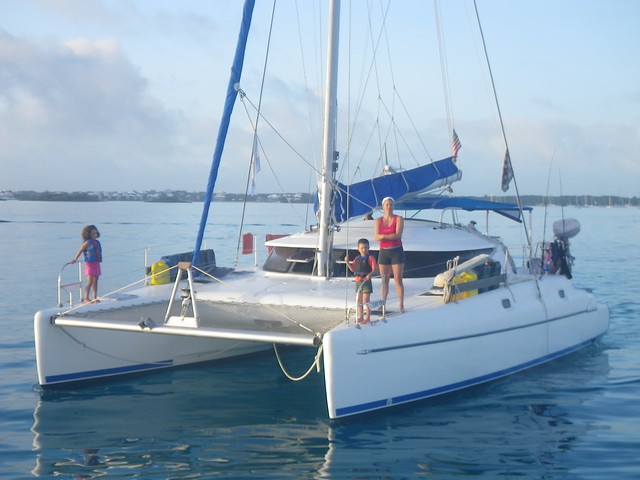We’ve been trying to get out of the marina for months. Don’t get me wrong, we love it there – a little too much actually. But we felt the need to detach, to do something more along the lines of what we bought the boat for. After living in a marina too long, we start to ask ourselves why we live on a boat at all. It was past time for a reminder.
But leaving the dock is hard. The longer we’re there, the harder it is to get away. The comforts and conveniences work their way so deep, we think we can’t live without them. Like OMG, it’s almost July, we can’t turn off the air conditioner, WE’LL DIE! Never mind that we spent a whole summer in the Keys without air. We’ve battled heat, humidity, and ninja mosquitos, and prevailed.
I previously said we wanted to go up to the Chesapeake for the summer. It was a noble goal and we were really excited about it, but we couldn’t get our ducks in a row to leave. Boat projects dragged out, we spent far too much money on them so that I had to accept some work I didn’t really want, and then the air conditioner came on and it was hurricane season.
Things finally reached a critical mass. Something had to be done, and we began preparing for a departure. We didn’t have a real solid destination in mind, but we were generally trying to get over to the FL East Coast. It was always sort of assumed that the next time we left Bradenton our first stop would be the Dry Tortugas. After returning from the Bahamas, it felt like the Tortugas were practically in our back yard, a scant 180 miles away.
All the items were checked off the departure list more or less on time, and the only thing left was the one we couldn’t control… the weather. With a tropical thing brewing down near the Yucatan, which would eventually become TS Debby, the Tortugas didn’t seem doable. At our boldest, we’re still fair weather sailors, and after a year at the dock, we weren’t feeling very bold.
The wind had been steady from the E for days, which is great for the trip back and forth to the Tortugas, but was forecasted to shift S and maybe W depending on how the storm developed. We couldn’t use the S to get down there, and didn’t want any part of strong W winds. The weather would probably be rainy and nasty down there anyway, so we decided to take the last day of E and get down to Charlotte Harbor just to make progress. We knew we could batten down and take a tropical storm there if necessary.
However, once we got out to the Gulf, the Charlotte Harbor plan wasn’t looking so good. The E wind was already thinking about being SE, and there was a S swell I didn’t expect. Actually, I had seen that detail during my weather research, but discounted and forgot about it. The result was that we couldn’t make near the necessary speed to get to Charlotte Harbor by dark, and bashing into waves wasn’t making anyone happy.
This wasn’t what we’d bargained for and we had no need to torture ourselves, so we bailed out. We did a 180 and headed back to Tampa Bay. With the waves now behind us, our retreat was 100% faster than our advance.
Slightly demoralized, and without a plan, we were at a loss about where to go. Should we go back to the marina? The suggestion was unspoken, but it was hanging in the air. I think Tanya and I both wanted it, but neither wanted to admit it. It would have felt like such a failure to go running straight back to our slip. Eventually it was Aaron who made the decision. He wanted Terra Ceia.
Terra Ceia is a bay-within-a-bay. Much of it is grassy flats, but it has a well-marked channel to an interior with plenty of water. It is busy with fishing boats on the weekend but otherwise is very quiet. It is almost totally surrounded by mangroves, and despite being only 3 miles from our marina, it has a very remote feeling.
This was the destination of our very first multi-day cruise many years ago. We’d never been back, but there was something fitting about going there now. For several days we swam, fished, and kayaked, and generally just enjoyed the boat while waiting out the weather.
There was something else fitting about being in Terra Ceia since that is our presumed hurricane hole for the Bradenton area. We’re still watching Debby warily and don’t have any confidence in NOAA’s forecast tracks, which just recently moved her landfall from Texas to Pensacola, and even that not for another four days. It seems like she could come our way just as easily.
We’ve already had more of Debby than we bargained for with two squalls so far with sustained winds of over 40 knots. We have a new personal record with our instruments recording 47.3 knots during the second squall, which sustained 40-45 knots for over 5 minutes. We’re only set with 5:1 scope, but the GPS shows we hardly moved at all – and that probably just due to the chain catenary, since we moved forward again after the squall passed. I’m going to kiss that anchor if we can ever dig it out. That was money well spent.
What we’ll do next we still don’t know. I need to travel for a while, so we’ll probably end up at a dock somewhere for the rest of the summer. Maybe we’ll try again for the other coast after this weather passes. Or maybe we’ll feel like we’ve had a little break and a little bit of adventure, and can go back to Bradenton contented.





